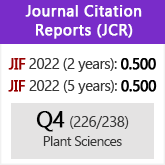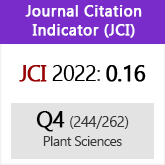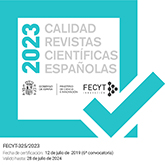The Mycorrhizae: a plant-fungus relation that has existed for more than 400 million years
DOI:
https://doi.org/10.3989/ajbm.2226Keywords:
Mycorrhizae, origin, evolution, symbiosisAbstract
The concept of mycorrhiza is considered in a wide sense, as a not necessarily mutualistic symbiosis, covering the trophic relations of mycorrhizal fungi with “inferior” and achlorophyllics plants. A bibliographical review of the origin and diversification of mycorrhizae is made. The pioneering characteristics of the arbuscular mycorrhiza formed by Glomeromycota are discussed, emphasizing its importance during the terrestrialization processes. The chronological appearance of the other types of mycorrhizas is discussed. The independent and recurrent evolution of the ectomycorrhizas formed by Basidiomycota and Ascomycota is discussed; their saprobiont or parasite origin points to the versatile nutritional strategy of these fungi, in adaptative response to environmental changes, as does the origin of the singular ericoid, arbutoid and helianthemoid mycorrhizas. The particular trophic relation between achlorophyllic plants, such as Monotropa and orchids, in their heterotrophic phases, with their “mycorrhizal” fungi is also described. Finally, the recent evolution of the non mycotrophic root systems is commented on.
Downloads
References
Arditti, J. 1977. Orchid Biology: Reviews and Perspectives I. Cornell University Press, London. Pp 25-46.
Barea, J.M. & Honrubia, M. 2004. La micorrización dirigida de la planta forestal. In: Vallejo, R. & al. (ed.), Avances en el estudio de la gestión del monte mediterráneo. CEAM. 84-921259-3-4. Pp: 215-260.
Berbee, M.L. & Taylor, J.W. 1993. Dating the radiations of the true fungi. Canadian Journal of Botany 71: 1114-1127.
Berbee, M.L. & Taylor, J.W., 2001. Fungal molecular evolution: genes trees and geologic time. In: McLaughin/McLaughin/Lemke (eds.), The Mycota VII Part B. Systematics and Evolution. Springer-Verlag Berlin Heiidelberg. Pp. 229-245.
Berbee, M.L. & Taylor, J.W., 2007. Rhynia Chert: a window into a lost world of complex plant-fungus interactions. New Phytologist 174: 475-479. doi:10.1111/j.1469-8137.2007.02080.x PMid:17447903
Bidartondo, M.J. & Bruns, T. 2005. On the origins of extreme mycorrhizal specificity in the Monotropoideae (Ericaceae): performance trade-offs during seed germination and seedling development. Molecular Ecology 14: 1549-1560. doi:10.1111/j.1365-294X.2005.02503.x PMid:15813793
Bonfante, P & Genre, A. 2008. Plants and arbuscular mycorrhizal fungi: an evolutionary-developmental perspective. Trends in Plant Science 13: 492-498. doi:10.1016/j.tplants.2008.07.001 PMid:18701339
Brundrett, MC. 2002. Coevolution of roots and mycorrhizas of land plants. New Phytologist 154: 275-304. doi:10.1046/j.1469-8137.2002.00397.x
Brundrett, MC. 2004. Diversity and classification of mycorrhizal associations. Biological Reviews 79: 473-495. doi:10.1017/S1464793103006316 PMid:15366760
Brundrett MC. 2008. Mycorrhizal Associations: The Web Resource. Date accessed. ‹mycorrhizas.info›.
Bruns, T. & Shefferson, R.P. 2004. Evolutionary studies of mycorrhizal fungi: milestones and future directions. Canadian Journal of Botany 82: 1122-1132. doi:10.1139/b04-021
Cairney, J.W. 2000. Evolution of mycorrhiza systems. Naturwissenschaften 87: 467- 475. doi:10.1007/s001140050762 PMid:11151665
Cairney, J.W.G. & Ashford, A.E. 2002. Biology of mycorrhizal associations of epicrids (Ericaceae). New Phytologist 154: 305-326. doi:10.1046/j.1469-8137.2002.00398.x
Carrión, JS. 2003. Evolución vegetal. DM. ISBN 84-8425-335-X. 497 pp.
Cazares, E. & Smith, J.E. 1996. Ocurrence of arbuscular mycorrhizae in Pseudotsuga menziesii and Tsuga heterophylla seedlings grown in Oregon Coastal range soils. Mycorrhiza 6: 65-67.
Comandini, O; Contu, M. & Rinaldi, A.C. 2006. A overview of Cistus ectomycorrhizal fungi. Mycorrhiza 16: 381-395. doi:10.1007/s00572-006-0047-8 PMid:16896800
Díaz, G., Barrantes, O., Honrubia, M. & Gracia, C. 1996. Effect of ozone and sulphur dioxide on mycorrhizae of: Pinus halepensis Miller. Ann. Sci. For. 53: 849-856. doi:10.1051/forest:19960404
Ding, T-Y. 1995. Origin, divergence and geographical distribution of Salicaceae. Acta Botanica Yunnanica 17: 277-290.
Dreyer, B., Morte, A., López, J.A. & Honrubia, M. (en preparación). Comparative root morphology and anatomy of four palm species and their relation with the mycorrhizal susceptibility and morphology.
Duckett, J.G. & Ligrone, R. 2005. A comparative cytological analysis of fungal endophytes in the sporophyte rhizomes and vascularized gametophytes of Tmesipteris and Psilotum. Canadian Journal of Botany 83: 1443-1456. doi:10.1139/b05-102
Duckett, JG., Carafa, A & Ligrone, R. 2006. A highly differentiated glomeromycotean association with the mucilage-secreting, primitive abtipodean liverwort Treubia (Treubiaceae): clues to the origin of mycorrhizas. American Journal of Botany 93: 797-813. doi:10.3732/ajb.93.6.797
Ellul, P., Boscaiu, M., Vicente, O., Moreno, V. & Rosselló, J.A. 2002. Intra- and Interspecific Variation in DNA Content in Cistus (Cistaceae). Annals of Botany 90: 345-351. doi:10.1093/aob/mcf194 PMid:12234146
Fassi, B. 1957. Ectomycorhizie chez le Gnetum africanum Welw. due a Scleroderma sp., Bulletin de la Société Française de Mycologie 73: 280-285.
Frank B. 1885. Über die auf Wurzeisymbiosen beruhende Ernährung gewisser Bäume durch unterirdische Pilze. Ber Deutsch Bot Ges 3: 128-145.
Gargas, A. DePriest, PT., Grube, M. & Theler, A. 1995. Multiple origins of lichen symbioses in fungi suggested by SSU rDNA phylogeny. Science 268: 1492-1495. doi:10.1126/science.7770775 PMid:7770775
Genre, A., Chabaud, M., Timmers, T., Bonfante, P. & Barker, DG.2005. Arbuscular mycorrhizal fungi elicit a novel intracellular apparatus in Medicago truncatula root epidermal cells before infection. Plant Cell 17: 3489-3499. doi:10.1105/tpc.105.035410 PMid:16284314 PMCid:1315383
Genre, A., Chabaud, M., Faccio, A., Barker, DG. & Bonfante, P. 2008. Prepenetration apparatus assembly precedes and predicts the colonization patterns of arbuscular mycorrhizal fungi within the root cortex of both Medicago truncatula and Daucus carota. Plant Cell 20: 1407-1420. doi:10.1105/tpc.108.059014 PMid:18515499 PMCid:2438458
Giovannetti, G. & Fontana, A. 1982. Mycorrhizal synthesis between Cistaceae and Tuberaceae. New Phytol. 92: 533-537 doi:10.1111/j.1469-8137.1982.tb03412.x
Gutiérrez, A., Morte, A. & Honrubia, M. 2003. Morphological characterization of the mycorrhizae formed by Helianthemum almeriense Pau with Terfezia claveryi Chatin and Picoa lefebvrei (Pat.) Maire. Mycorrhiza 13: 299-307. doi:10.1007/s00572-003-0236-7 PMid:12721817
Guzmán, B. & Vargas, P. 2005. Systematics, character evolution, and biogeography of Cistus L. (Cistaceae) based on ITS, trnLtrnF, and matK sequences. Molecular Phylogenetics and Evolution 37: 644-660. doi:10.1016/j.ympev.2005.04.026 PMid:16055353
Heckman, D.S., Geiser, D.M., Eidell, B.R., Stauffer, R.L., Kardos, N.L. & Hedges, S.B. 2001. Molecular evidence for the early colonization of land by fungi and plants. Science 293: 1129-1133. doi:10.1126/science.1061457 PMid:11498589
Hibbett, D.S. Gilbert, L.B. & Donoghe, M.J. 2000. Evolutionary instability of ectomycorrhizal symbioses in basidiomycetes. Nature 407: 506-508. doi:10.1038/35035065 PMid:11029000
Honrubia, M. & Díaz, G. 1996. Effect of simulated acid rain on mycorrhizae of Aleppo pine (Pinus halepensis Miller). Ann. Sci. For. 53: 947-954. doi:10.1051/forest:19960503
Honrubia, M., Torres, P., Díaz, G., Barreno, E., Morte, A., Sánchez, F., Pérez, P. & Sánchez-Saorín, J.A. 1997. Efectos de las micorrizas en la restauración de las zonas afectadas por incendios forestales en la Comunidad Valenciana. 345-393 pp. In La Restauración de la Cubierta Vegetal en la Comunidad Valenciana. Ed. Centro de Estudios Ambientales del Mediterráneo CEAM. Generalitat Valenciana. Conselleria deAgricultura y Medio Ambiente. ISBN 84-921259-0-X.
Honrubia, M., Morte, A. & Díaz, G. 2002. Dinamismo del componente fúngico micorrícico y su incidencia en la regeneración del bosque mediterráneo. In: Charco, J. (coord.), La regeneración natural del bosque mediterráneo en la península Ibérica: evaluación de problemas y propuesta de soluciones. ARBA-MMA (eds.), ISBN 84-922095-5-0. Pp: 87-113.
Honrubia, M., Morte, A. & Gutiérrez, A. 2007. Las Terfezias. Un cultivo para el desarrollo rural en regiones áridas y semi-áridas. In: Reyna, S. (coord.), Truficultura, Fundamentos y Técnicas, Capítulo 10. Pp. 365-397. Ediciones Mundi-Prensa, Madrid.
Ji, Q., Li, H., Bowe, M., Liu, Y. & Taylor, D.W. 2004. Early Cretaceous Archaefructus eoflora sp. nov. with Bisexual Flowers from Beipiao, Western Liaoning, China. Acta Geologica Sinica 78: 883-896.
Kiers, E.T. & Van der Heijden, M.G. 2006. Mutualistic stability in the arbuscular mycorrhizal symbiosis: exploring hypothesis of the evolutionary cooperation. Ecology 87: 1627-1636. doi:10.1890/0012-9658(2006)87[1627:MSITAM]2.0.CO;2
Koch, M.A. & Mummenhof, K. 2006. Editorial: Evolution and phylogeny of the Brassicaceae. Pl. Syst. Evol. 259: 81-83. doi:10.1007/s00606-006-0433-x
Konzalova, M., 1967. Paleontologicke zprava klokalite. Archiv Geoindustria, Geofond, Prague.
Kottke, I & Nebel, M. 2005. The evolution of mycorrhiza-like associations in liverworts: an update. New Phytologist 167: 330-334. doi:10.1111/j.1469-8137.2005.01471.x PMid:15998388
Krings M., Taylor. T.N., Hass, H., Kerp., H., Dotzler, N & Hermsen, E.J. 2007. Fungal endophytes in a 400-million-year-old land plants: infection pathways, spatial distribution, and host responses. New Phytologist 174: 648-657. doi:10.1111/j.1469-8137.2007.02008.x PMid:17447919
LePage, B.A., Currah, RS., Stockey, RA & Rothwell, GW. 1997. Fossil ectomycorrhizae from the Middle Eocene. American Journal of Botany 84: 410-410. doi:10.2307/2446014
Lewis, D.H. 1987. Evolutionary aspects of mutualistic associations between fungi and photosynthetic organisms. In: Rayner, A.D.M., Brasier, C.M. & Moore, D. (eds.), Evolutionary biology of the fungi. Cambridge University Press, Cambridge. Pp. 161-178.
Li, JQ., 1996. The origin and distribution of the family Fagaceae. Acta Phytotaxonomica Sinica 34: 376-396.
Ligrone, R., Carafa, A., Lumini, E., Bianciotto, V., Bonfante P. & Duckett, J.G. 2007. Glomeromycotean associations in liverworts: a molecular, cellular, and taxonomic analysis. American Journal of Botany 94: 1756-1777. doi:10.3732/ajb.94.11.1756
Mabberley, DJ. 1997. The plant-book. A portable dictionary of the vascular plants. Cambridge: Cambridge University Press.
Malloch, D.W., Pirozynski, K.A. & Raven, P.H. 1980. Ecological and evolutionary significance of mycorrhizal symbioses in vascular plants (A Review). Proceedings of the National Academy of Sciences USA 77: 2113-2118. doi:10.1073/pnas.77.4.2113
Massicotte, H.B., Melville, L.H., Molina, R., Peterson, R.L. 1993. Structure and histochemistry of mycorrhizar synthesized between Arbutus menziessi (Ericaceae) and two basidiomycetes, Pisolithus tinctorius (Pisolithaceae) and Piloderma bicolor (Corticiaceae). Mycorrhiza 3: 1-11. doi:10.1007/BF00213461
McGee, P.A., Bullock, S. & Summerell, B.A. 1999. Structure of mycorrhizae of Wollemi Pine (Wollemia nobilis) and related Araucariaceae. Australian Journal of Botany 47: 85-95. doi:10.1071/BT97064
Morte, A., Honrubia, M. & Gutiérrez, A. 2008. Biotechnology and Cultivation of Desert Truffles. In: A. Varma (ed.). Mycorrhiza. Biology, Genetics, Novel Endophytes and Biotechnology. 3rd edition, Chapter 38. Springer-Verlag. Heidelberg, New York. Pp. 467-483.
Moyersoen B. 2006. Pakaraimaea dipterocarpacea is ectomycorrhizal, indicating an ancient Gondwanaland origin for the ectomycorrhizal habit in Dipterocarpaceae. New Phytologist 172: 753-762. doi:10.1111/j.1469-8137.2006.01860.x PMid:17096800
Nan, L. 1995. Studies on the geographic distribution, origin and dispersal of the family Pinaceae Lindl. Acta Phytotaxonomica Sinica 32: 105-130.
Navarro, A., Sánchez-Blanco, M.J., Morte, A., Bañon, S. (En prensa). The influence of mycorrhizal infection on water and nutritional status of Arbutus unedo L. treated and not treated with paclobutrazol. Environmental and Experimental Botany.
Nebel, M., Kreier, HP., Preußing, M., Weiß, M. & Kottke, I. 2004. Symbiotic fungal associations of liverworts are the possible ancestors of mycorrhizae. In: Agerer, R., Piepenbring, M. & Blanz, P. (eds.), Frontiers in Basidiomycote Mycology. Eching, Germany: IHW-Verlag. Pp. 339-360.
Onguene, N.A. & Kuyper, T.W. 2001. Mycorrhizal associations in the rain forest of South Cameroon. Forest Ecology Management 140: 277-287. doi:10.1016/S0378-1127(00)00322-4
Pérez-Moreno, J. & Read, D. J. 2004. Los hongos ectomicorrícicos, lazos vivientes que conectan y nutren a los árboles en la naturaleza. Interciencia 29: 239-247.
Phipps, C.J. & Taylor, T.N. 1997. Mixed arbuscular mycorrhizae from the Triassic of Antarctica. Mycologia 88: 707-714. doi:10.2307/3760964
Pirozynski, K.A. 1980. Interactions between fungi and plants through the ages. Canadian Journal of Botany 59: 1824-1827.
Pirozynski, K.A. & Malloch, D.W. 1975. The origin of land plnats: a matter of mycotrophism. Biosystems 6: 153-164. doi:10.1016/0303-2647(75)90023-4
Pressel, S., Ligrone, R., Duckett, J.G. & Davis, E.C. 2008. A novel ascomycetous endophytic association in the rhizoids of the leaf liverwot family Schistochilaceas (Jungermanniidae, Hepaticopsida). American Journal of Botany 95: 531-541. doi:10.3732/ajb.2007171
Read, D.J., Duckett, J.G., Francis, R., Ligrone, R. & Russell, A. 2000. Symbiotic fungal association in “lower”plants. Phil. Trans. R. Soc. Lond. B. 355: 815-831. doi:10.1098/rstb.2000.0617 PMid:10905611
Redecker, D. 2002. Molecular identification and phylogeny of arbuscular mycorrhizal fungi. Plant and Soil 244: 67-73. doi:10.1023/A:1020283832275
Redecker, D., Kodner, R. & Graham, L.E. 2000. Glomean Fungi from the Ordovician. Science 289 (5486): 1920-1921. doi:10.1126/science.289.5486.1920 PMid:10988069
Remy, W., Taylor, T.N., Hass, H. & Kerp, H. 1994. Four hundredmillion- year-old vesicular arbuscular mycorrhizae. Proc. Nat. Acad. Sci. (USA) 91: 11841-11843. doi:10.1073/pnas.91.25.11841
Russell, J. & Bulman, S. 2005. The liverwort Marchantia foliacea forms a specialized symbiosis with arbuscular mycorrhizal fungi in the genus Glomus. New Phytologist 165: 567-579. doi:10.1111/j.1469-8137.2004.01251.x PMid:15720667
Schmidt, A.R., Dörfelt, H. & Perrichot, V. 2007. Carnivorous fungi from Cretaceous Amber. Science 318: 1743. doi:10.1126/science.1149947 PMid:18079393
Schüssler, A. 2000. Glomus claroideum forms an arbuscular mycorrhiza-like symbiosis with the hornwort Anthoceros punctatus. Mycorrhiza 10: 15-21. doi:10.1007/s005720050282
Schüssler, A., Schwarzott, D. & Walker, C. 2001. A new fungal phylum, the Glomeromycota: phylogeny and evolution. Mycol. Res. 105: 1413-1421. doi:10.1017/S0953756201005196
Selosse, MA. 2005. Are liverworts imitating mycorrhizas? New Phytologist 165: 345-349. doi:10.1111/j.1469-8137.2004.01298.x PMid:15720648
Selosse, M.A. & Le Tacon, F. 1998. The land flora: a phototrophfungus partnership. Tree 13: 15-20. doi:10.1016/S0169-5347(97)01230-5
Selosse, M.A., Setaro, S., Glatard, F., Richard, F., Urcelay, C. & Weiß, M. 2007. Sebacinales are common mycorrhizal associates of Ericaceae. New Phytologist 174: 864-878. doi:10.1111/j.1469-8137.2007.02064.x PMid:17504468
Simon, L., Bousquet, J., Levesque, R.C. & Lalonde, M. 1993. Origin and diversification of endomycorrhizal fungi and coincidence with vascular land plants. Nature 363: 67-69. doi:10.1038/363067a0
Smith, S. & Read, D. 2008. Mycorrhizal Symbiosis. 3er Ed. Academic Press. ISBN 9780123705266. 800 pp.
St. John,TV. 1980. A survey of mycorrhizal infection in a Amazonian rain forest. Acta amazonica 10: 527-533.
Sun, G., Ji, Q., Dilcher, D.L., Zheng, S., Nixon, K.C. & Wang, X. 2002. Archaefructaceae, a New Basal Angiosperm Family. Science 296: 899-904. doi:10.1126/science.1069439 PMid:11988572
Sung, G.H., Poinar, G.O. & Spatafora, J.W. 2008. The oldest fossil evidence of animal parasitism by fungi supports a Cretaceous diversification of fungal-arthropod symbioses. Molecular phylogenetics and evolution 49: 495-502. doi:10.1016/j.ympev.2008.08.028 PMid:18817884
Taylor, T.N., Remy, W., Hass, H. & Kerp, H. 1995. Fossil arbuscular mycorrhizae from the Early Devonian. Mycologia 87: 560-573. doi:10.2307/3760776
Taylor, T.N., Klavins S.D., Krings, M., Taylor, E.I., Kerp, H. & Hass, H. 2004. Fungi from the Rhynia chert: a view from the dark side. Transactions of the Royal Society of Edimburgh-Earth Sciences 94: 457-473.
Torres, P. & Honrubia, M. 1997. Changes and effects of a natural fire on ectomycorrhizal inoculum potential of soil in a Pinus halepensis forest. For. Ecol. Manag. 96: 189-196 doi:10.1016/S0378-1127(97)00058-3
Vajda, V. & McLoughlin, S. 2004 Fungal Proliferation at the Cretaceous-Tertiary Boundary. Science 303: 1489 doi:10.1126/science.1093807 PMid:15001770
Vajda, V., Raine, J.I. & Hollis, C.J. 2001. Indication of global deforestation at the Cretaceous-Tertiary Boundary by New Zealand fern spike. Science 294: 1700-1702. doi:10.1126/science.1064706 PMid:11721051
Vrälstad, T., Schumacher, T. & Taylor, A.F.S., 2002. Mycorrhizal synthesis between fungal strains of the Hymenoscyphus aggregate and potential ectomycorrhizal and ericoid hosts. New Phytologist 153: 143-152. doi:10.1046/j.0028-646X.2001.00290.x
Wang, B. & Qiu, Y.L. 2006. Phylogenetic distribution and evolution of mycorrhizas in land plants. Mycorrhiza 16: 299-363. doi:10.1007/s00572-005-0033-6 PMid:16845554
Willis, K.J. & McElwain, J.C. 2002. The evolution of plants. Oxford Univ. Press.
Wing, S.L. & Boucher, L.D. 1998. Ecological aspects of the Cretaceous flowering plant radiation. Annual Review of Earth and Planetery Science 26: 379-421. doi:10.1146/annurev.earth.26.1.379
Yuan, X., Xiao, S. & Taylor, T.N. 2005. Lichen-like symbiosis 600 Million year ago. Science 308: 1017-1020. doi:10.1126/science.1111347 PMid:15890881
Zhang, Y. & Guo, LD. 2007. Arbuscular mycorrhizal structure and fungi associated with mosses. Mycorrhiza. 17: 319-325. doi:10.1007/s00572-007-0107-8 PMid:17277943
Zhu, GL. 1995. Origin, differentiation and geographical distribution of Chenopodiaceae. Acta Phytotaxonomica Sinica 34: 486-504.
Downloads
Published
How to Cite
Issue
Section
License
Copyright (c) 2009 Consejo Superior de Investigaciones Científicas (CSIC)

This work is licensed under a Creative Commons Attribution 4.0 International License.
© CSIC. Manuscripts published in both the printed and online versions of this Journal are the property of Consejo Superior de Investigaciones Científicas, and quoting this source is a requirement for any partial or full reproduction.All contents of this electronic edition, except where otherwise noted, are distributed under a “Creative Commons Attribution 4.0 International” (CC BY 4.0) License. You may read here the basic information and the legal text of the license. The indication of the CC BY 4.0 License must be expressly stated in this way when necessary.
Self-archiving in repositories, personal webpages or similar, of any version other than the published by the Editor, is not allowed.

















